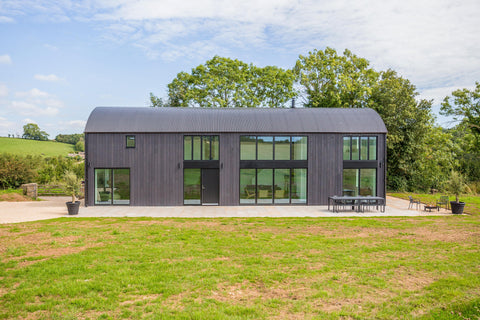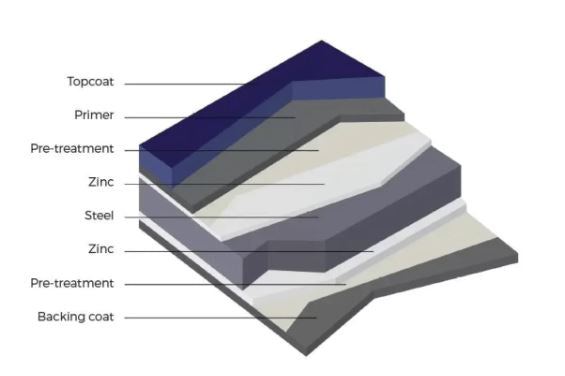Dripping or leaking is a frequent issue with corrugated roof sheets that many homeowners and builders encounter. Left unchecked, this can lead to moisture buildup, structural damage, and costly repairs.
As experts in roofing sheets, we will discuss practical strategies for preventing a corrugated roof from leaking, helping you maintain a dry, durable, and comfortable space.
Why Do Corrugated Roofs Drip?
If you've noticed dripping from your corrugated roofing sheets, it's likely due to condensation. Warm, humid air rises and meets the cooler surface of the roof, causing moisture to form. Poor ventilation, lack of insulation, and gaps from improper overlaps or inaccurate cutting of corrugated roofing sheets can worsen this.
Adding corrugated foam filler strips can help seal gaps at the sheet joints, preventing moisture buildup. Ensuring precise cuts, snug overlaps, and proper airflow can help reduce or even stop the dripping issues.
How to Stop a Corrugated Roof From Leaking
If your corrugated roof has started leaking, here are some strategies to control things.
Choose the Right Roofing Material
The roofing material can significantly impact the likelihood of dripping. Tile-effect metal roofing sheets are an excellent option, offering superior durability and a reduced risk of condensation compared to traditional materials.
Ensure Proper Ventilation
Ensuring adequate ventilation is critical to preventing condensation. Proper airflow helps regulate temperature and moisture levels, reducing the likelihood of condensation forming. Consider installing vents or fans, especially in attics directly beneath the roof.
Use a Dripstop Membrane
Applying a drip-stop membrane to corrugated sheets is a highly effective solution. This innovative product is designed to trap and hold condensation, preventing it from dripping. Over time, the trapped moisture evaporates into the air, significantly reducing the risk of water damage.
Install Insulation
Proper insulation plays a crucial role in temperature regulation. By insulating the space beneath the corrugated roof, you can minimise the temperature differential that leads to condensation. This not only helps prevent drips but also enhances the overall energy efficiency of your building.
Install Flashings
Flashings are essential in any roofing system, especially in preventing leaks and drips. Properly installed corrugated flashings can redirect water away from critical areas, such as joints and edges, thereby reducing the risk of dripping.
Perform Regular Maintenance and Inspections
Regularly inspecting your roof for signs of damage, such as cracks or gaps, is vital. Addressing these issues promptly can prevent water ingress, a common cause of dripping in corrugated roofs.
Maintain an Effective Guttering System
A well-designed guttering system is crucial for adequate water drainage. Durable options like metal guttering can improve water flow around the roof, reducing potential water damage, especially in heavy rainfall areas. Keeping gutters clean and blockage-free will further enhance this protective measure.
How to Stop Corrugated Plastic Roofing from Dripping
Corrugated plastic roofing sheets are famous for their lightweight, durable nature. Still, they can also be prone to dripping issues due to condensation. Like metal roofing, corrugated plastic sheets can accumulate condensation when warm air rises and cools upon contact with the colder plastic surface. By understanding how PVC vs. metal roofs handle temperature changes, you can better plan for insulation and ventilation strategies to reduce condensation buildup.
Here's how to address dripping issues with corrugated plastic roofing:
- Insulate and ventilate: Adding insulation beneath the corrugated plastic roofing can help stabilise temperatures and reduce condensation. Proper ventilation is also essential to allow humid air to escape, preventing moisture from accumulating on the surface.
- Seal overlaps: Plastic sheets must overlap correctly to avoid gaps that can let water seep through during rain. Apply a sealant or adhesive tape to keep overlaps tight and prevent leaks.
- Check the angle of installation: Install corrugated plastic roofing at an angle to encourage water runoff and reduce the chances of water pooling or condensation building up on the sheets.
Quick DIY Solutions to Prevent Corrugated Roof Leaks
You can easily tackle minor leaks with a few simple steps:
- Seal gaps and overlaps: Apply waterproof silicone sealant along the overlaps and joints where panels meet. This quick fix helps keep water from seeping through.
- Install foam filler strips: Add foam strips along the ridges and valleys to block any small gaps where water or wind might get in. This also helps keep your roof insulated.
- Reinforce weak points with roofing tape: Place roofing tape along seams and around screw holes for extra waterproofing.
- Check your roof slope and drainage: Ensure your roof is angled to allow water runoff and keep gutters clear to prevent pooling.
- Tighten screws and fasteners: Inspect screws regularly and replace any loose ones with roofing screws that have rubber washers to create a tighter seal.
Tip: Regularly checking these areas, especially after heavy rain, helps prevent leaks from becoming bigger issues.
Long-Term Benefits of Addressing Corrugated Roof Dripping
Preventing roof dripping provides several long-term benefits, from safeguarding your property against water damage to extending your roofing system's lifespan. Proactively tackling these issues avoids costly repairs and enhances energy efficiency by reducing moisture buildup, which can lower heating and cooling costs. Ultimately, implementing these solutions leads to a more comfortable, secure, and durable living environment, free from the frustrations of leaks and drips.


One of our customers completed a recent corrugated roofing project.
Frequently Asked Questions
How do we stop corrugated roofs from leaking?
Prevent leaks in a corrugated roof by sealing any gaps, overlaps, and screw holes with a waterproof silicone or rubber sealant, ensuring that all fasteners are securely tightened.
How do you waterproof a corrugated roof?
Waterproof a corrugated roof by applying a high-quality waterproof coating or sealant over the entire surface, focusing on seams, overlaps, and fastener areas to create a protective, moisture-resistant barrier.
What is the best way to seal a corrugated metal roof?
The best way to seal a corrugated metal roof is to use a flexible polyurethane sealant on all joints, fasteners, and seams, followed by a specialised roofing sealant coating for complete waterproofing.
How can water leakage from tin roofs be stopped?
To stop water leakage from a tin roof, inspect and replace any damaged screws or washers, and apply a waterproof sealant over seams and edges where leaks are most likely to occur.

